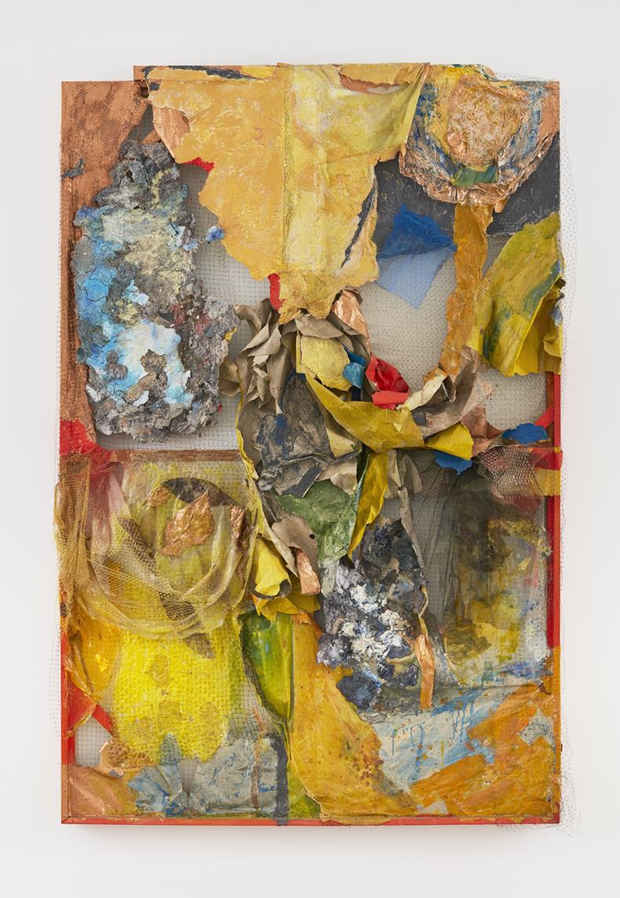“Off The Wall” Exhibition
Mnuchin Gallery

[Image: Suzanne Jackson "Alice playing harp, her veils in the wind" (2017), acrylic, layered acrylic detritus, laundry lint, scenic Bogus paper, lace, netting, and wood, 104 x 76 x 12 in.]
This event has ended.
Curated by Sukanya Rajaratnam
Mnuchin Gallery presents Off the Wall, featuring groundbreaking works by Sam Gilliam, David Hammons, Suzanne Jackson, Al Loving, and Joe Overstreet. The exhibition examines radical methods each of these artists employed, starting in the late sixties but continuing through the present, to deconstruct what a painting could be, essentially removing it from its traditional two-dimensional confines. Releasing the canvas from its stretcher was a radical notion when it was pioneered, and its effects continue to shape art-making practices today.
The sixties were marked by radical revolution and change, both politically and artistically. It was in this context that Gilliam, Loving, and Overstreet began to question what new possibilities painting offered. For Gilliam, the breakthrough answer to that question occurred in 1968. Already experimenting with dyeing and folding the canvas, he started to explore different ways to mount his paintings. A fortuitous moment involving a corner of a tacked-up canvas slipping from the wall sparked a new direction for the artist: the Drape paintings.[1] Hanging from the ceiling or wall in bunches and inhabiting the viewer’s space, the Drapes question what a painting can be and how an audience can interact with these pieces on a phenomenological level, making them more of an environment than a statically fixed object.
After achieving notoriety in the late 1960s and early 1970s with his hard-edge geometric paintings, Al Loving realized that this style was not an adequate reflection of his artistic vision. This began a bold, total shift to what has been dubbed the “torn canvases.” In these works, strips of fabric are painted or dyed, then sewn together in overlapping patterns and shapes, and mounted so they jut out of the wall, creating shadows that become a part of the composition. The series draws its origins from Loving’s memories of his mother and grandmother sewing quilts together when he was a young boy and attending the Abstract Design in American Quilts exhibition at the Whitney Museum of American Art in 1971. The torn canvases not only play with one’s perception of pictorial space, they collapse painting and collage in on each other, elevating craft as an art form and acting as a vehicle for Loving’s personal and artistic liberation.
Around this same time, Overstreet began his Flight Pattern series, in which vibrant abstract canvases are mounted from the wall, ceiling, or floor with ropes and grommets, bending and twisting and alive with movement, recalling a kite in flight. Inspired by the nomadic lifestyle of his youth and the political unrest of the time, the Flight Pattern paintings speak to the violence enacted on Black bodies by evoking the lynchings still unfortunately common at that time. Yet, they are simultaneously laced with a distinctly hopeful quality through their colors and titles.
While Hammons and Jackson were active during this time, Off the Wall will highlight more recent work in their respective practices. Over the past decade, Jackson has begun to fuse her artmaking with her background in theater design, for which she received an MFA from Yale in 1990. For her series of “anti-canvases,” Jackson piles layers of acrylic paint directly onto a table covered in plastic, then peels it off and hangs the drying paint like a canvas, allowing her to layer acrylic on acrylic without the need for traditional support.[2] She then imbues these works with found objects and detritus from her studio, including netting, old ballet costumes, peanut shells, bells, loquat seeds, and leather string. Made to look like theater scrims, these “anti-canvases” will sometimes also incorporate bogus paper, a type of material used during set building, which she pinches and crimps to lend an even more lyrical aura to her work.
Hammons’s Tarp Paintings poke fun at the mighty canon of Abstract Expressionism and its intense desirability within the market. Taking the signature gestural brushstroke of that movement as a readymade unto itself, Hammons paints beautiful abstract canvases subsequently shrouded from view by adding tarps, plastic wrap, or other found materials. These works stand almost statuesque in their confrontation and tactility, challenging the limits between painting and sculpture, and infusing the self-seriousness of the movement with the absurdist language of Dada.
The desire seen in each of the five artists to blur these boundaries reflects their shared interest in the deconstructive nature of jazz—particularly the work of John Coltrane—and an intrinsically personal attempt to break free from the oppressive structures placed on them as Black Americans. In taking their art off the walls, each of them taps into a long and vital lineage, telling stories about both painful and uplifting realities of Black histories through innovative spatial structures.
[1] Jenelle Porter, “Composed,” in Sam Gilliam: Green April (Los Angeles: David Kordansky Gallery, 2016), 25.
[2] Julia Felsenthal, “An Artist Who Makes Paintings Without a Canvas,” The New York Times Style Magazine, November 19, 2019, accessed February 1, 2021.
Media
Schedule
from April 27, 2021 to June 05, 2021
Artist(s)
Sam Gilliam, David Hammons, Suzanne Jackson, Al Loving, Joe Overstreet